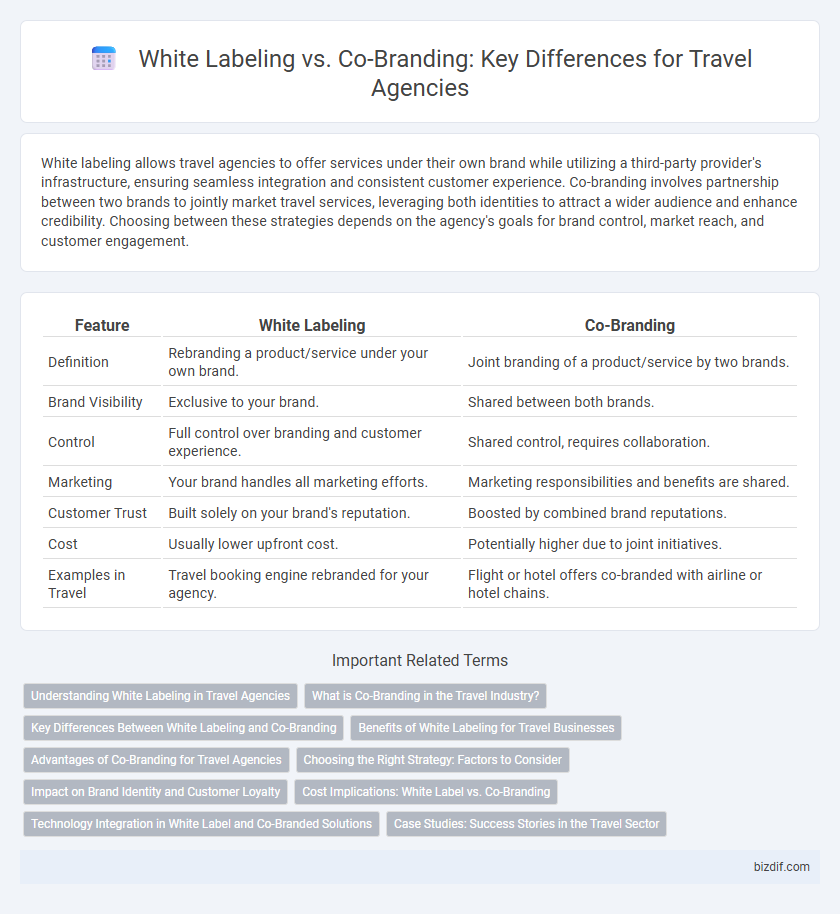White labeling allows travel agencies to offer services under their own brand while utilizing a third-party provider's infrastructure, ensuring seamless integration and consistent customer experience. Co-branding involves partnership between two brands to jointly market travel services, leveraging both identities to attract a wider audience and enhance credibility. Choosing between these strategies depends on the agency's goals for brand control, market reach, and customer engagement.
Table of Comparison
| Feature | White Labeling | Co-Branding |
|---|---|---|
| Definition | Rebranding a product/service under your own brand. | Joint branding of a product/service by two brands. |
| Brand Visibility | Exclusive to your brand. | Shared between both brands. |
| Control | Full control over branding and customer experience. | Shared control, requires collaboration. |
| Marketing | Your brand handles all marketing efforts. | Marketing responsibilities and benefits are shared. |
| Customer Trust | Built solely on your brand's reputation. | Boosted by combined brand reputations. |
| Cost | Usually lower upfront cost. | Potentially higher due to joint initiatives. |
| Examples in Travel | Travel booking engine rebranded for your agency. | Flight or hotel offers co-branded with airline or hotel chains. |
Understanding White Labeling in Travel Agencies
White labeling in travel agencies allows companies to offer travel products and services under their own brand while sourcing and managing inventory from third-party providers. This strategy enables agencies to build customer loyalty and expand their portfolio without the complexities of product development or direct supplier relationships. White labeling enhances market reach by delivering personalized travel experiences with minimal operational overhead.
What is Co-Branding in the Travel Industry?
Co-branding in the travel industry involves two or more brands collaborating to offer joint products or services, leveraging each other's strengths to enhance customer experience and market reach. This strategy often combines a travel agency with airlines, hotels, or credit card companies to create exclusive packages, loyalty programs, or branded experiences. Co-branding boosts brand visibility and customer loyalty by integrating multiple trusted travel-related brands into a seamless service offering.
Key Differences Between White Labeling and Co-Branding
White labeling in travel agencies involves one company offering products or services under another company's brand, allowing seamless integration without revealing the original provider. Co-branding combines two distinct brand identities to create a joint offering that benefits from the brand equity of both partners. Key differences include brand visibility, with white labeling emphasizing the reseller's brand exclusively, whereas co-branding promotes shared brand recognition and collaborative marketing efforts.
Benefits of White Labeling for Travel Businesses
White labeling offers travel businesses the ability to expand their product offerings swiftly without investing in infrastructure, enabling seamless integration of booking platforms under their brand. This approach enhances customer trust and loyalty by providing a consistent brand experience while benefiting from the technology and inventory of established suppliers. Cost-effective scalability and reduced operational complexities make white labeling a strategic advantage for travel agencies aiming to grow efficiently.
Advantages of Co-Branding for Travel Agencies
Co-branding enables travel agencies to leverage the established reputation and customer base of partner brands, enhancing credibility and expanding market reach. This strategy facilitates shared marketing costs and resources, resulting in increased brand visibility and customer trust. Collaborations in co-branding also foster innovation through combined expertise, allowing agencies to offer unique travel packages and exclusive deals that attract a broader audience.
Choosing the Right Strategy: Factors to Consider
Choosing the right strategy between white labeling and co-branding depends on factors such as brand control, market reach, and resource investment. White labeling offers seamless integration with full control over customer experience, making it ideal for agencies prioritizing brand consistency. Co-branding leverages the strengths of two brands to expand customer base and share marketing costs, suitable for agencies aiming to enhance credibility and access new markets.
Impact on Brand Identity and Customer Loyalty
White labeling allows travel agencies to offer services under their own brand, strengthening brand identity by maintaining consistent customer experiences and fostering direct customer loyalty. Co-branding combines the reputation of two brands, enhancing market reach but potentially diluting individual brand identity, which can lead to mixed customer perceptions and varied loyalty levels. Choosing between white labeling and co-branding significantly impacts how customers associate trust, recognition, and loyalty with the travel agency's brand.
Cost Implications: White Label vs. Co-Branding
White labeling in travel agencies typically involves lower upfront costs since the agency leverages an existing platform without investing heavily in branding development, whereas co-branding requires shared expenses for marketing and brand integration. Co-branding often demands higher long-term financial commitments due to joint advertising campaigns and collaborative technology updates, impacting budget allocation more significantly than white labeling. Agencies must assess their financial capacity and strategic goals to choose between the cost-efficiency of white labeling and the potentially stronger market presence offered by co-branding.
Technology Integration in White Label and Co-Branded Solutions
White labeling in travel technology integrates seamlessly with existing platforms, offering customizable interfaces that maintain the agency's brand identity while leveraging robust backend systems. Co-branded solutions combine technologies from both the travel agency and the service provider, enabling shared branding and collaborative user experiences with joint access to data analytics. Both approaches enhance booking engines, payment processing, and customer management systems, but white labeling emphasizes complete technological control under one brand, whereas co-branding focuses on synergistic technology partnerships.
Case Studies: Success Stories in the Travel Sector
Leading travel agencies like Expedia have successfully implemented white labeling by allowing smaller agencies to offer customized booking platforms under their own brand, resulting in increased market reach and customer loyalty. Co-branding partnerships such as the collaboration between American Express and Hilton Honors have driven mutual growth by combining premium travel rewards with exclusive hospitality experiences, boosting customer engagement and retention. Case studies from Booking.com demonstrate how strategic co-branding with airlines enhances seamless travel experiences, leading to higher conversion rates and expanded customer bases.
White labeling vs Co-branding Infographic

 bizdif.com
bizdif.com